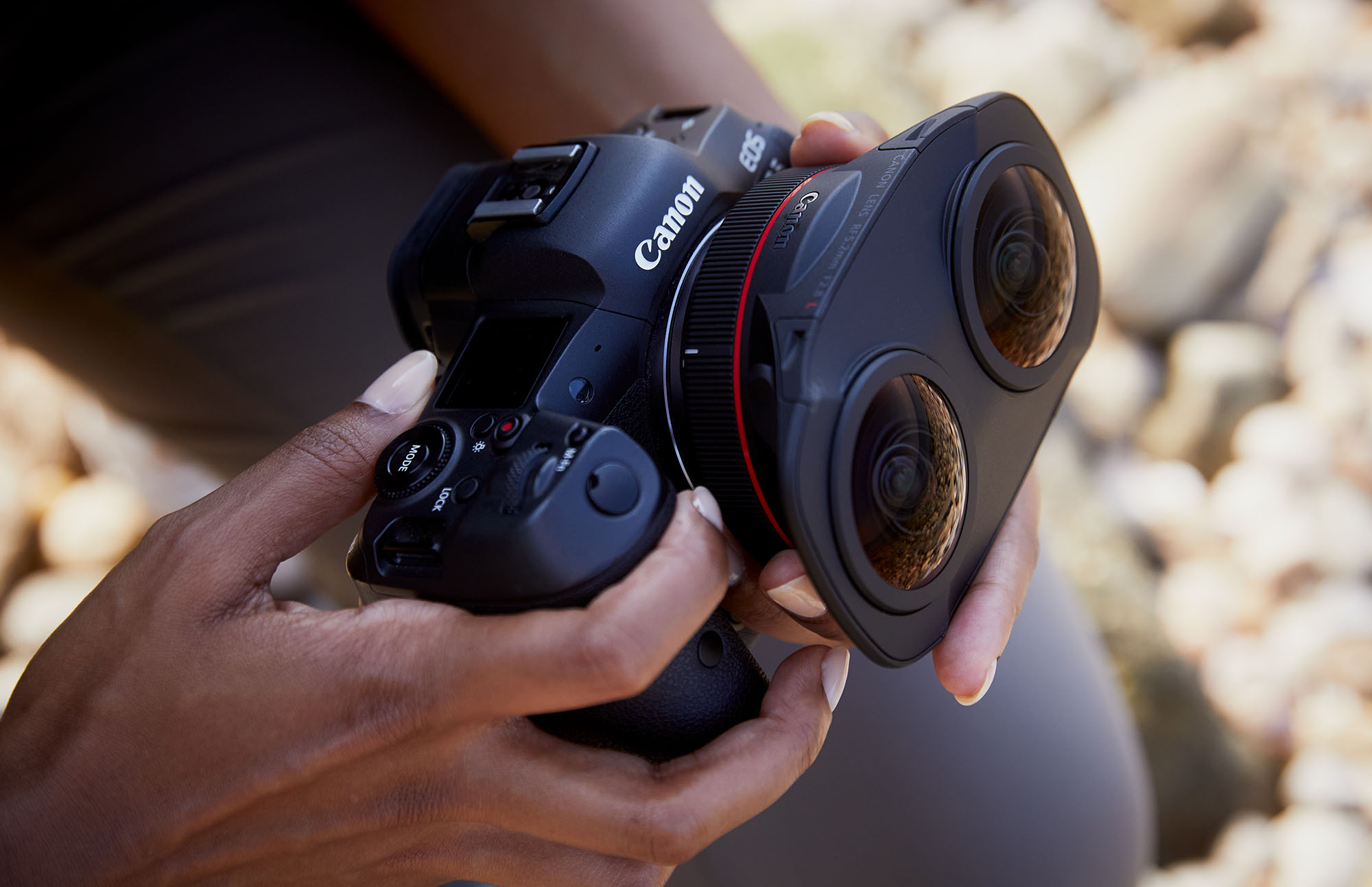
Canon made an unexpected product announcement. It revealed a dual-RF mount fisheye lens as part of the brand new EOS VR system. Its goal is to transform virtual reality (VR), and augmented reality production by making workflow easier than existing VR capture systems while still delivering the same quality as a full-frame mirrorless digital camera.
The key product is the $1999 RF5.2mmF2.8 L Dual Fisheye Manual Lens, which was designed to mount on Canon’s 8K-capable EOS R5 camera. This product is unusual in appearance, with the two fisheye lenses mounted side-by-side. To match human interpupillary distance, they are placed 60mm (24 in) apart. This provides comfortable parallax for AR and VR.
Canon
This lens is compatible with Canon's EOS R5, which Canon chose for its 8K video capabilities. It projects two circular images onto the 45-megapixel sensor of the camera when it is shooting. It can capture 190-degree footage and photos in stereoscopic 3D at up to 8,192x4,096 (8K resolution) for AR or VR applications.
There are some unique features to the lens, such as a ring that simultaneously focuses both lenses and an Allen screw adjustment that allows you to adjust the focus of each lens to match the other. You also get the usual features found in Canon L RF mount glass like dust-resistant sealing, coatings to reduce flare and ghosting, and an F2.8 to F16 aperture range. Despite its odd appearance, the lens is quite compact and only slightly larger than Canon's 35mm F1.8 lens.
Canon
However, the lens is only one component of the equation. Canon is currently working on a firmware upgrade for the R5 that will include new features to support both the lens and EOSVR system. This includes manual focus confirmation via Canon's Dual Pixel autofocus system and MF peaking. There is also a Magic Window UI to help users plan delivery to different headset types.
Canon also created its EOS VR Utility app and EOS VR Plugin app, which can be subscribed for $5 per month, with a free trial period. The VR Utility app flips stereo images from left to right, and converts them into a square "equirectangular" image that can be viewed with a VR headset. You can also use it to edit clips, apply a LUT and trim them. It also lets you choose from preset file types and resolutions (DPX Pro Res, H264, etc.). Before export.
Canon explained to Engadget that Adobe Premiere also has the EOS VR plug in. This "will convert dual fisheye imagery into equirectangular, while permitting the ability to cut and color with the full control over Premiere Pro." You can also export the footage to your preferred spec for different delivery methods.
You can also use Canon's EOS Utility and Camera Connect to control the capture. Canon stated in a press release that both apps will be updated to provide "remote control and live view functionality for monitoring purposes while traveling", as Canon explained in a press release.
This system is ideal for weddings, journalism and sports as well as training. It also offers a number advantages over existing VR cameras. It's built to be more accurate than standalone VR cameras using smaller lenses and sensors, such as the Insta360 Pro 2 for $5,000. You also get all of the R5's features like log shooting and RAW capture. The R5 can also be used for regular video production and photo shoots even if you don't use the VR lens.
Canon
The production process is also simpler and more affordable than dual cameras in high-end productions. These cameras need to be properly rigged, synced and focused. In many cases, there will be two files. Canon's EOSVR system, on the other hand, offers similar quality, but allows for focus and setup just like regular cameras, leaving you with one file to edit at end.
The total cost of the entire system is $5,898. It is a niche lens that I was surprised to find it so affordable. R5 overheating is another issue that limits 8K recording time to 20 minutes with a 10-minute recovery. However, you can increase that amount by recording 8K to an external Ninja RAW recorder. This will add $1,500 to the cost.
It looks promising for VR production. This has been a popular trend since the COVID-19 pandemic, though it is still not mainstream. It has been very popular for business training and collaboration. This could be a rich area for video producers. Many of these people, especially those who already own a Canon EOS R5, may be open to VR work if Canon’s new system proves to be as simple to use as promised. The EOS VR system and the lens are expected to arrive in December 2021.